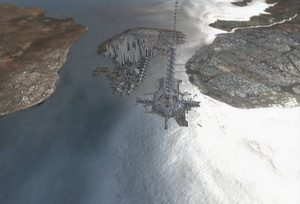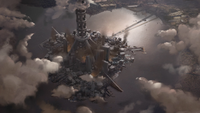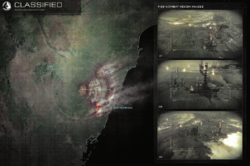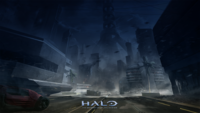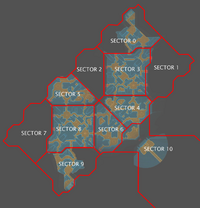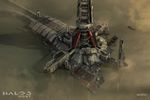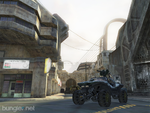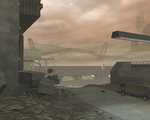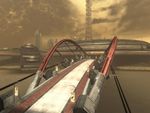Mombasa
From Halopedia, the Halo wiki
| There is more information available on this subject at Mombasa on the English Wikipedia. |
| Mombasa | |
|---|---|
 A lion logo associated with Mombasa | |
| Overview | |
|
Location: |
|
|
Population: |
Millions[1] |
|
Notable structure(s): |
|
Mombasa[2] is a major Earth city[3] in the Republic of Kenya; a member state of the East African Protectorate.[4] The heart of the city was the prosperous New Mombasa on Mombasa Island. The nearby mainland was the site of Old Mombasa, a comparatively run-down district.[5] Mombasa was considered a megacity.[6]
Mombasa is considered one of the most renowned and majestic cities on the planet and the "heart and soul" of the East African Protectorate.[7] The city's sea wall was famous.[8]
Mombasa was the site of Earth's first Space elevator[5] and centuries later, was a battlefield in the climactic year of the Human-Covenant War.[9][10] Most, if not the entire city was destroyed in this battle[11][12][13] requiring reconstruction through Project Rebirth.[14][15]
Overview
Geography
Mombasa Island, where the metropolis of New Mombasa lies, is separated from the mainland by two creeks: Tudor Creek to the north and Kilindini Harbor to the south. Northwest of the island and between the inlets, there may be a large peninsula, connected to the Mombasa island by the Makupa Causeway.[Note 1] Outside of the city and outside of Voi were the New Mombasa badlands.[16]
Old Mombasa
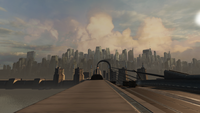
- Main article: Old Mombasa
Much of the mainland was known as Old Mombasa. This includes parts of the mainland south and southwest of Kilindini Harbour.[9][4]
The moniker of Old Mombasa was applied to all municipalities in a 74 km radius of Mombasa.[5]
Locations
- Grid Kilo 23
- Mombasa Quays
- Obote
- Makupa
- Kwakiziwi
- Koinage
- Nyali
- Mtongwe Station
- Hope Station
- Makupa
- Sector 0-5
New Mombasa
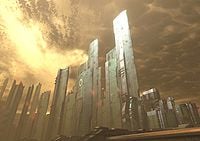
- Main article: New Mombasa
New Mombasa encompasses the entirety of Mombasa Island,[5] as well as some mainland territories.[4]
The City Center spans much of the Southeast portion of the island, being divided in multiple walled sectors.[Note 2]
While the majority of New Mombasa has been divided to numbered sectors, some districts such as Mbaraki, Kizingo or Kikowani still retain their original names. The original names are often seen in the names of streets or train stations, for example. Some of the districts' names have changed, albeit slightly; areas originally referred to as Tangana and Liwatoni are now referred to as Tanaga and Liwitoni, respectively. The locations of some districts have changed as well. This is the case with most of the districts on the southern side of the island, where the sea has claimed large areas of land.[13]
On the outskirts of New Mombasa existed an industrial wasteland where a UNSC munitions testing complex sat.[19]
Locations
|
Known residents
- Endesha family
- Sadie Endesha
- Daniel Endesha - Works department engineer
- Mike Branley - NMPD officer
- Roberto Bustamante - NMPD officer
- Jim Odingo - NMPD officer
- Marshall Glick - NMPD officer
- Carlos Wambua - Toll booth operator
- Tom Uberti - Salesman
- Melody Azikiwe - UEG Diplomatic Corps envoy
- Kinsler - NMPD commissioner
- Jonas - Kebab salesman
- Stephen - Public service announcer
- Communications Duty Officer
- Unnamed NMPD Officer
History
Interstellar Era
Mombasa underwent dramatic change with the arrival of the interstellar era. In response to increasing demand for cheap orbital access, due to its economic stability and prominent location, Mombasa was chosen to be Earth's first Space Elevator city.[20] The government began construction on one of the wonders of the age: a space elevator (Mombasa's proximity to the equator made it an ideal location) in 2302.[5] This structure served to lift heavy cargo into geosynchronous orbit without expensive booster rockets filled with fuel.
Over the next eleven years the city experienced explosive growth, but nothing compared to what followed. The city grew out as well as up, its urban sprawl unequaled throughout the continent.[5]
Mombasa would change dramatically within the centuries that followed. By 2430, New Mombasa had absorbed the entire island and many of the surrounding towns, which became overrun by residents of Mombasa. The switch of name was never official, and though many of the neighborhoods within direct line of sight to the Mombasa Tether still distributed newspapers and Chatter directories under their previous names, all municipalities within a 74 km radius of the island became referred to as "Old Mombasa."[5]
On December 19, 2512, the Superintendent was activated to manage the city's infrastructure.[21]
Human-Covenant
- Main article: Battle of Mombasa
On October 20, 2552, a small group of Covenant capital ships arrived at Earth. Uninformed of the Human presence on Earth, Regret was outnumbered and outgunned against the UNSC Home Fleet. During the orbital battle, the Prophet of Regret's flagship broke through Earth's defenses and descended to the atmosphere, and anchored itself above New Mombasa.[9] The Covenant started deploying their ground forces to the city, in search of a Forerunner relic, the Ark Portal, buried under the city.[22]
However, due to a strong UNSC counterattack and the inferior numbers of the Covenant, Regret ordered all of his forces to be evacuated back aboard the Carrier. After this, the ship jumped into slipspace just above the city, releasing a shock wave and pulling multiple city blocks from the mainland with it.[10] This event became known as the "New Mombasa Slipspace Event."[23] After sending in ground forces and crushing the remaining UNSC resistance in the city in hours after Regret's retreat, the remaining ships of the initial fleet along with a larger Covenant fleet glassed the area in order to uncover the Portal the next day.[24][13] In the final days of the Battle in Africa, only smoldering ruins of Mombasa remained.[12] Though some areas like Haller Street did survive somewhat intact.[15]
Post-war
Following the end of the war, the East African Protectorate began planning an ambitious and expensive project to rebuild the destroyed urban core.[15]
Around the same time, the Unified Earth Government began Project Rebirth to rehabilitate war torn areas on Earth.[25] UEG investments through Rebirth and UNSC activity at the nearby Portal at Voi did revitalize some of the city.[15] Eventually as well through Rebirth, the old city hall thoroughfare for Mombasa was to be transformed into the UNSC Memorial Park.[14]
Government and society
Leadership and management
New Mombasa has a mayor.[14] The Superintendent, a second generation "dumb-AI,"[21] managed many of the municipal functions in New Mombasa[26] and in Old Mombasa.[17]
Service organizations and utilities
Numerous departments existed in Mombasa including; the Department of Health and Human Services, the Department of Housing, the Department of Public Safety, the Department of Recreation, the Department of Streets and Sanitation, and the Department of Utilities and Transportation.[27] The city also maintained a public works department.[28]
The transit of Mombasa is run by the New Mombasa Transit Authority. They are known to operate the extensive Maglev train network within the city.[26][29]
The New Mombasa Police Department is the police force of the city. They have stations in Old Mombasa[17] and their headquarters is located in New Mombasa.[30]
The waste management of the city is handled by the New Mombasa Waste Management. They operate all sorts of garbage cans throughout New Mombasa and Old Mombasa. They also operate the Olifant.[13]
Some parks and greenspace in Mombasa is handled by the New Mombasa Parks and Recreation. They managed the Uplift Nature Reserve.[13]
Mail in New Mombasa was handled by the NMPost.[26]
The small industrial town of Voi helped to provide water, power, and transportation for Mombasa.[6]
Economy
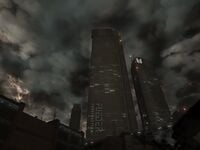
The economy of Mombasa is vast, with numerous corporations from various industries residing in or otherwise operating in the city.
On the smaller end, with singular known locations, there are hotels such as Hotel Zanzibar, Palace Hotel and one unidentified hotel which all dotted the city. The smaller Voi Theater provided entertainment and Arney Antics was a smaller gun shop. Smaller restaurants such as The Roost Star and Kuku's Cafe provided food to the citizens of the city,
Service based corporations like African Trust, Vyrant Telecom and Atlas Communications Corporation owned offices in the city. Vyrant Telecom owned the tallest office tower, and Atlas provided services as well.
Heavy industry, construction, and defense corporations Jotun Heavy Industries, Traxus Heavy Industries, SinoViet Heavy Machinery, EnerGuide, Fueder Construction, Lethbridge Industrial, Hannibal Weapon Systems, Misriah Armory, AMG Transport Dynamics, and Cascade Stronghold Technologies all operated either industrial buildings or office towers across the city. New Mombasa Uplift which held offices in the city also operated the space elevator.
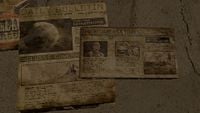
Culture
Media and entertainment
Multiple media organizations exist within Mombasa. The city has two newspapers, the Daily Bulletin and The Mombasa Times. Mombasa also had its own circus called the Mombasa Circus. As well, rock concerts were held in the city by bands such as Fluke of the Narwal.[17]
Architecture and infrastructure
The architecture of the city is different depending on the location. Old Mombasa's architecture was an odd hodgepodge of old and new: 16th-century Muslim arcades, aging 21st-century office buildings, looming 26th-century power couplings, old concrete homes secured with computerized locks. Clotheslines strung next to power lines, and mechanical gates set into ancient brick walls.[9][17] In some areas, newer skyscrapers had found their home.[13][31]

New Mombasa is composed differently. In the southeastern city centre there is more use of a dense commercial focused arcology,[26] while elsewhere, it is more focused on large industrial designs.[10]
People
The culture also seems displaced between the different parts of the city; while New Mombasa was populated with industrial workers and ambitious cosmopolitans, Old Mombasa was considered to be more of an old rundown slum that deteriorates by the day. The denizens of the old city were largely isolated from the residents of New Mombasa; even their dialect was completely different from the standard language.[22]
Gameplay
Mombasa and surrounding areas appear numerous times in Halo games.
Halo 2
- Main articles: Halo 2, Halo 2: Anniversary
Mombasa is one of the locations visited in Halo 2's campaign. It is featured in two campaign levels; Outskirts which takes place in Old Mombasa and Metropolis which mostly takes place in the industrial zone of New Mombasa. Several multiplayer maps take place in the Mombasa area as well. Terminal, Ivory Tower, Tombstone, District, and Turf are all in various locations and various points in the city's history.
Halo 3
- Main article: Halo 3
Mombasa is not a playable space in Halo 3's campaign. However its ruins can be seen in Tsavo Highway and The Storm across the other side of The Portal. The Mombasa area, specifically the Mombasa Quays, is playable in the map Longshore from the Mythic II Map Pack.
Halo 3: ODST
- Main article: Halo 3: ODST
Save for the very final cutscene, every level of Halo 3: ODST's campaign and every map in Firefight take place in Mombasa. Most prominently, the levels and maps are set in the New Mombasa city center. Mombasa Streets allow players to explore several sectors of the city center. The placement of some landmarks, like the Orbital elevator is different than what is seen in Halo 2.
Halo: Reach
- Main article: Halo: Reach
A mainland portion of Mombasa is playable in the map Breakneck as part of the Anniversary Map Pack. Numerous landmarks can be seen outside the boundaries of the playable space. This version appears to be very similar to ODST's design of the city, though some elements of the city geography do not line up with any known depiction of Mombasa.
Halo: Spartan Strike
- Main article: Halo: Spartan Strike
The city is seen in the first operation of Spartan Strike; Operation A: Orphic Spear, and in the first half of the last operation, Operation E: Brother's Keeper. All the missions on the first operation and first half of the last one take place in New Mombasa and takes elements from Halo 2 and ODST.
Halo Infinite
- Main article: Halo Infinite
The Haller Street area of the city is playable in the multiplayer map Bazaar.
Production notes
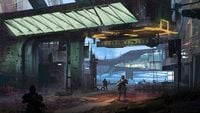
The Mombasa area was first seen during the Halo 2 E3 demo where it was significantly different than designs of the city seen in released media. In the demo, the city was a large tree like structure stretching into the sky. This structure was removed for the final game where the designers wanted the city to feel more real. They then based it more on the actual city using photographs to help imagine what it would look like 500 years into the future.[32]
During the production of Halo 4, concept art by Michael Pedro was produced for a potential multiplayer map set in "Mombasa Heights".[33]
Gallery

|
Browse more images in this article's gallery page. |
Mombasa area after the Battle of Mombasa.
List of appearances
- I love bees (First mentioned)
- Halo 2 (First appearance)
- Halo Graphic Novel
- Halo: Ghosts of Onyx (Mentioned only)
- Halo 3
- Halo 3: ODST
- Halo: Evolutions
- Halo: Reach
- Halo: Spartan Strike
- Halo: New Blood
- Hunt the Truth (Mentioned only)
- Halo: Spartan Strike
- Halo Mythos
- Halo: Legacy of Onyx (Mentioned only)
- Halo: Bad Blood (Mentioned only)
- Halo: Renegades
- Halo Infinite
Notes
- ^ This landmass was shown to be covered by water in Halo 3: ODST. This could be explained by the dramatic climbing of sea levels due to global warming, whose results are evident throughout Mombasa. Or by the creation of an artificial seaway that reaches further inland. It's also possible that this simply wasn't created for the in-game area as the only way to see that far west is in Panoramic Camera Mode
- ^ In Sadie's Story, multiple areas seen in the ODST campaign are referred to as the city center. This includes Kikowani Station (Audio log 1, Circle 1, Arc 1), ONI Alpha Site and the New Mombasa Data Center (Audio log 8, Circle 3, Arc 2), the NMPD headquarters (Audio log 24, Circle 8, Arc 3), and the area in which the Solemn Penance arrived at (Audio log 3, Circle 1, Arc 3).
Sources
- ^ Sadie's Story, Circle 2, Arc 3
- ^ Halo: Mortal Dictata, chapter 3
- ^ Halo: The Essential Visual Guide, page 54
- ^ a b c Halo Waypoint, New Mombasa (Retrieved on Jun 1, 2020) [archive]
- ^ a b c d e f g Bungie.net: Field Guide entry: New Mombasa
- ^ a b Halo: The Essential Visual Guide, page 201
- ^ Halo: The Essential Visual Guide, page 129
- ^ Halo: Evolutions, Palace Hotel
- ^ a b c d Halo 2, campaign level Outskirts
- ^ a b c Halo 2, campaign level Metropolis
- ^ Halo 2, multiplayer map Tombstone
- ^ a b Halo 3, campaign level Tsavo Highway
- ^ a b c d e f Halo 3: ODST, campaign level Coastal Highway
- ^ a b c McFarlane Toys/Halo Point Prizes, Master Chief Statue Press Release
- ^ a b c d Halo Waypoint, Canon Fodder - Showcase Sensitive (Retrieved on Jun 16, 2021) [archive]
- ^ Halo 3, Easter egg, Missing Person Poster
- ^ a b c d e f g Halo 2: Anniversary, campaign level Outskirts
- ^ Halo 3: ODST, campaign level Uplift Reserve
- ^ Bungie.net, An Affinity for Art (Retrieved on Jun 1, 2020) [archive]
- ^ Halo Waypoint: "Space Elevator" article (Archived on Archive.org)
- ^ a b Halo Waypoint: Superintendent
- ^ a b Halo Graphic Novel, Second Sunrise Over New Mombasa
- ^ Halo 3, multiplayer map High Ground
- ^ Halo Waypoint, Canon Fodder - Vergil Reality (Retrieved on Jun 15, 2021) [archive]
- ^ Halo: Legacy of Onyx, chapter 2
- ^ a b c d e Halo 3: ODST, campaign level Mombasa Streets
- ^ Bungie.net, Intel - Superintendent (Retrieved on Jun 1, 2020) [archive]
- ^ Halo 3: ODST, Field Operations Guide FM 90-10-140
- ^ Halo 2, multiplayer map Terminal
- ^ Halo 3: ODST, campaign level NMPD HQ
- ^ Halo: Reach, multiplayer map Breakneck
- ^ Youtube, First Look Halo 2 (Retrieved on Jun 1, 2020) [archive]
- ^ Artstation, Halo 4, Michael Pedro (Retrieved on Jun 1, 2020) [archive]
| ||||||||||||||||||||||||||||||||
